GSTR-4
The GSTR-4 report includes the details of taxable outward and inward supplies, including supplies under reverse charge, made by a GST composition dealer in a given period.
GSTR-4 Report
You can generate the GSTR-4 in TallyPrime with the details required for filing returns.
View the report with the details required for filing returns
- Go to Gateway of Tally > Display > Statutory Reports > GST > GSTR–4.
Alternatively, press Alt+G (Go To) > type or search GSTR-4 > Press Enter. - Click F12: Configure and enable both the options.
- Press F2 to change the report period.
The report appears as shown: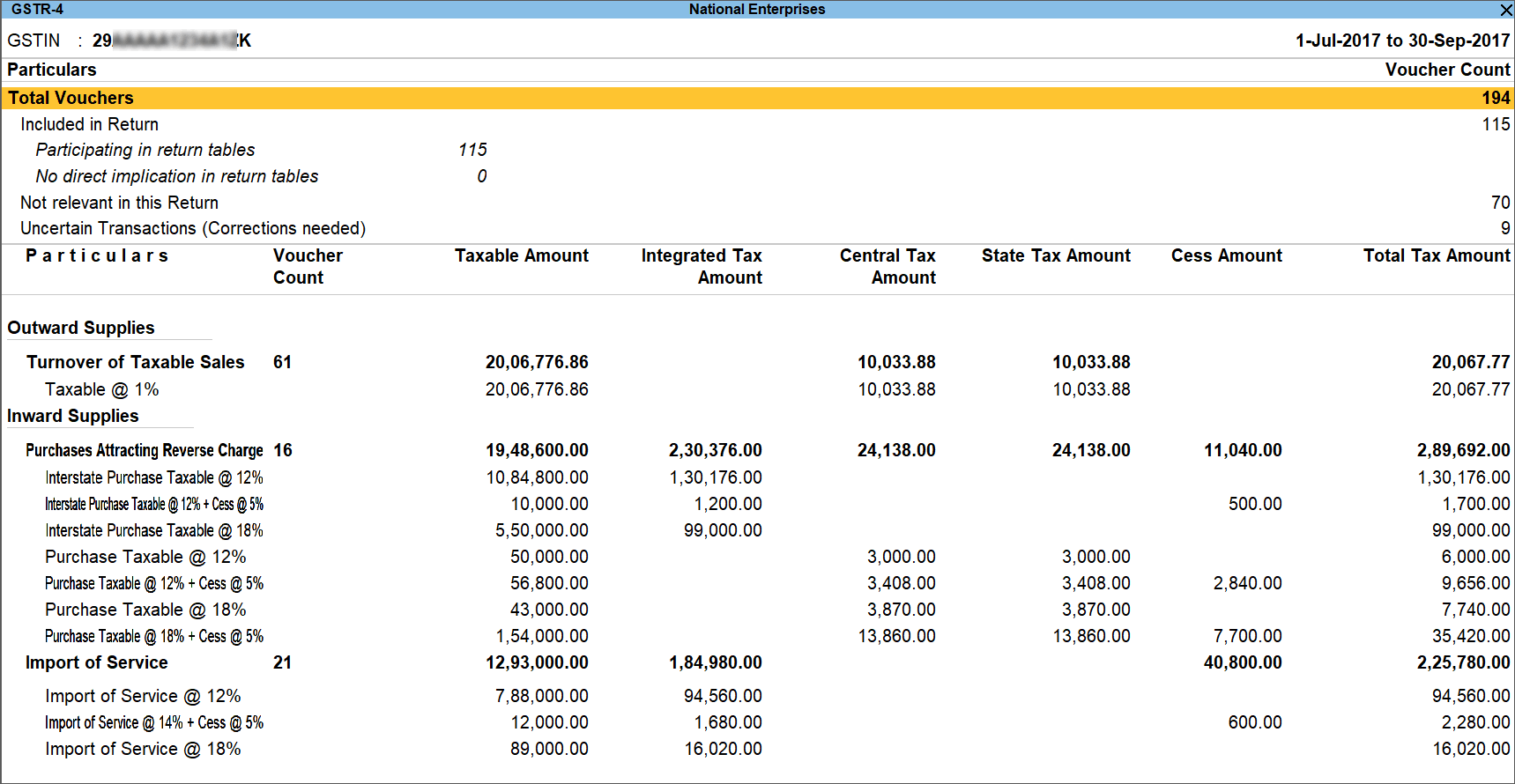
- Click F1: Detailed to view the breakup of sales and sales returns.
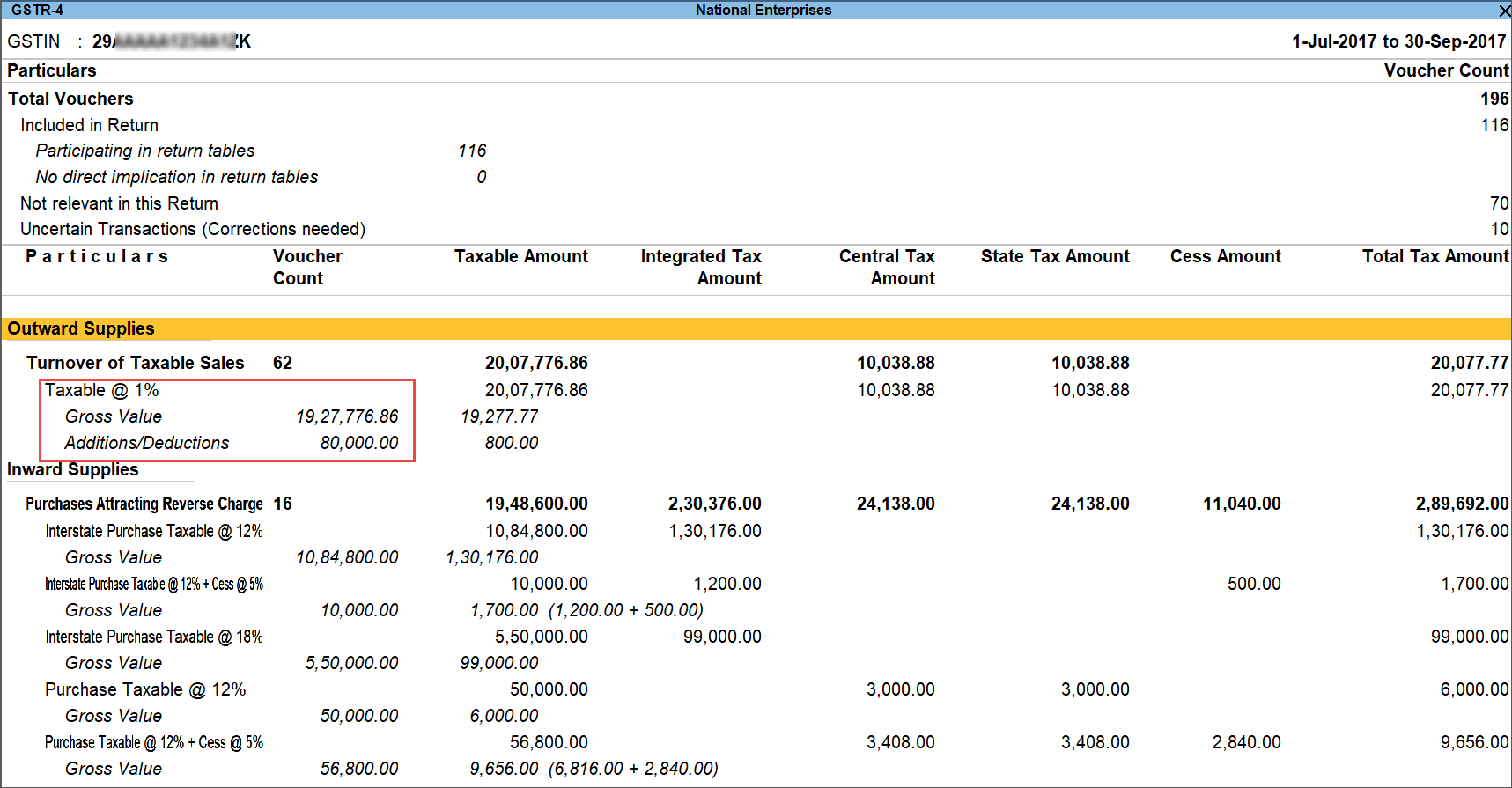
If you have more than one tax rate in the return period, based on the date of applicability, the break-up of nett value appears for taxable sales.
There are two sections in this report:
- Returns summary, which is a snapshot of the business operations in the given period.
- Particulars, which displays transactions participating in the returns.
Returns Summary
This section provides a summary of all transactions recorded in the reporting period. You can drill down on each row to view the details.

Total number of vouchers for the period
Drill-down shows the Statistics report, listing the vouchers participating in the GST returns.
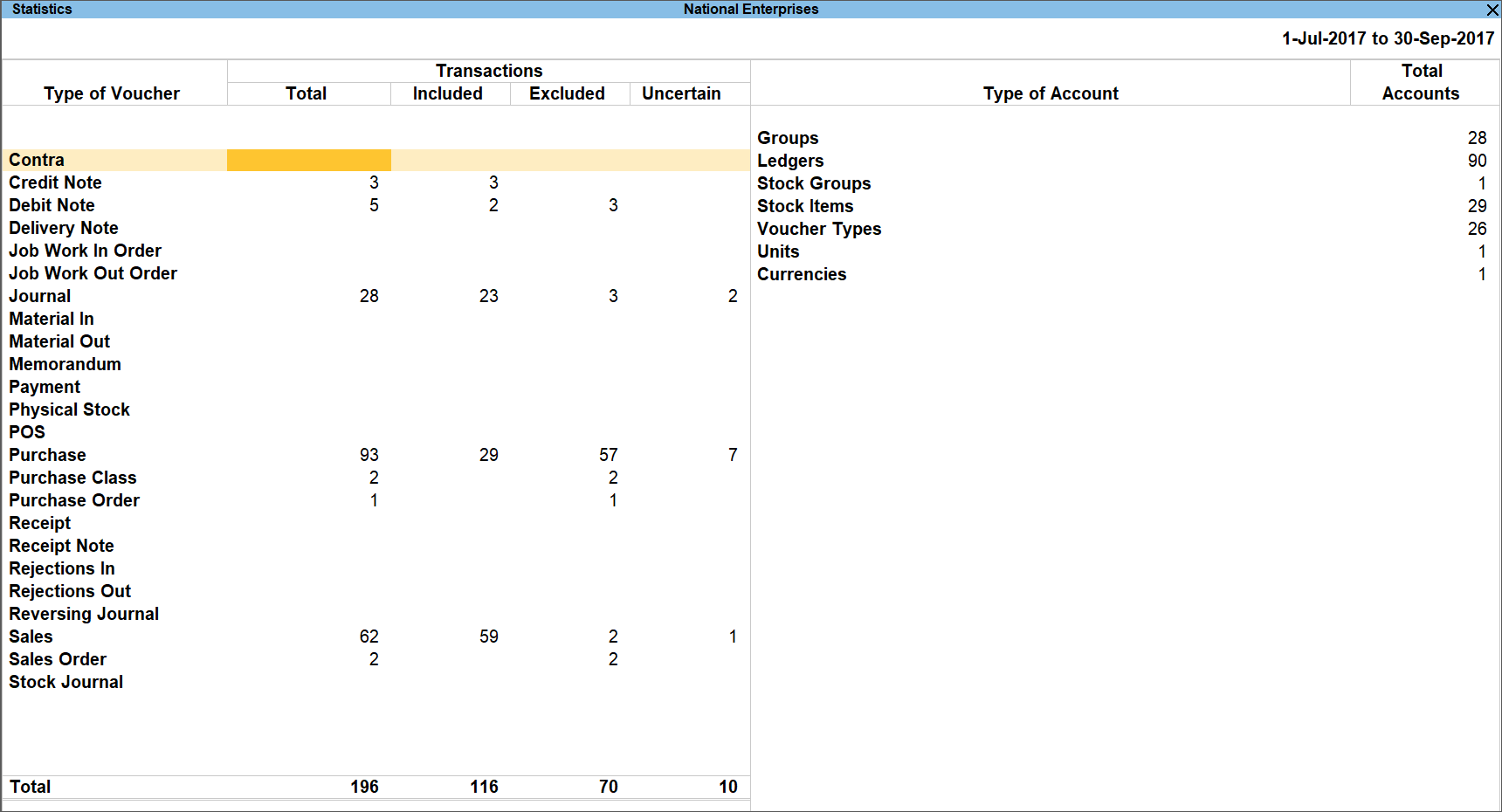
Included in returns – Displays the number of vouchers that are:
- Participating in the returns: Displays the number of vouchers that are part of the return tables. This includes nil-rated transactions. Drill down to view the Summary of Included Vouchers.

- No direct implication in return tables: Displays the number of exempt sales that do not have an impact on the GSTR-4 returns. Drill down to view the Summary of Included Vouchers.

Not relevant for returns
Drill down from this row to view the Summary of Excluded Vouchers report, with the voucher count based on the transaction type.

Other transaction types that can appear under excluded vouchers:
- Excluded by User: Displays transactions manually excluded from the list of included or uncertain transactions. Drill down and click I: Include Vouchers, if required. Based on the information in the voucher, it will move to either included or uncertain.
- No GST Implications: Displays the count of receipts, payments, and journal vouchers that do not have any GST implication.
- Non GSTR-4 Transactions: Displays the transactions which are part of other returns, for example: GSTR–1, GSTR-2 or GSTR-3B and hence will not have any implication on GSTR–4.
Based on the available transactions, the relevant categories appear with the voucher count.
Incomplete/Mismatch in information (to be resolved)
Displays the count of all vouchers for which information required for filing returns is missing in the invoice. You can correct exceptions in the vouchers before exporting GST returns.
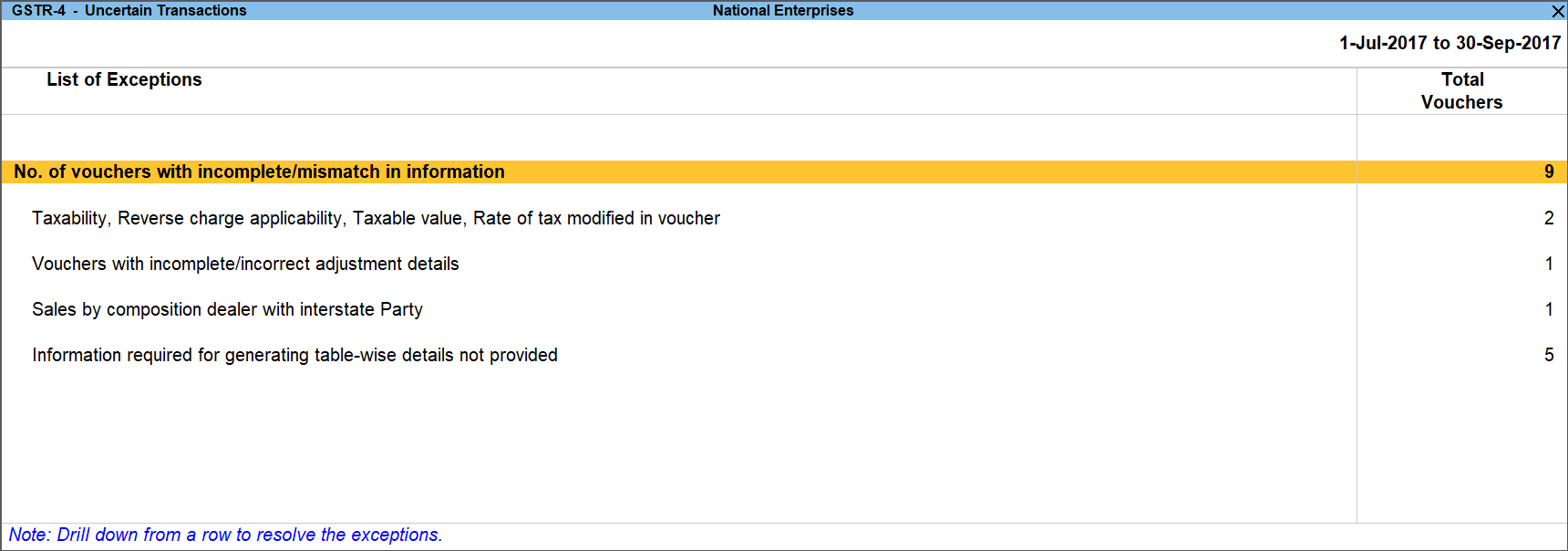
The exceptions are listed in the order of priority, based on the importance of the information to generate the returns. You need to update the missing information and resolve the mismatches to include them in the returns.
Exception: Taxability, Reverse charge applicability, Taxable value, Rate of tax modified in voucher
Displays the count of transactions in which the nature of transaction, taxable value or rate of tax defined in the ledger master has been changed in the transaction.
- Select the exception Taxability, Reverse charge applicability, Taxable value, Rate of tax modified in voucher, and press Enter.

- Select the required voucher.
- Select the relevant transaction, click R: Resolve, and enter the details manually. You can also click A: Accept as is if you do not want to change any information.
- Press Enter to accept. Similarly, accept the required vouchers.
- Press Ctrl+A to accept.
Exception: Vouchers with incomplete/incorrect adjustment details
Displays the count of journal vouchers in which the Nature of adjustment is not selected.
- Select the exception Voucher with incomplete/incorrect adjustment details, and press Enter.

- Select the Nature of Adjustment and Additional Details for each voucher.
- Accept the screen. As always, you can press Ctrl+A to save.
Exception: Sales by composition dealer with interstate Party
Displays the count of transactions recorded with party located outside the state, as such transactions are not allowed by GSTN.
- Select the exception Sales by composition dealer with interstate Party, and press Enter.
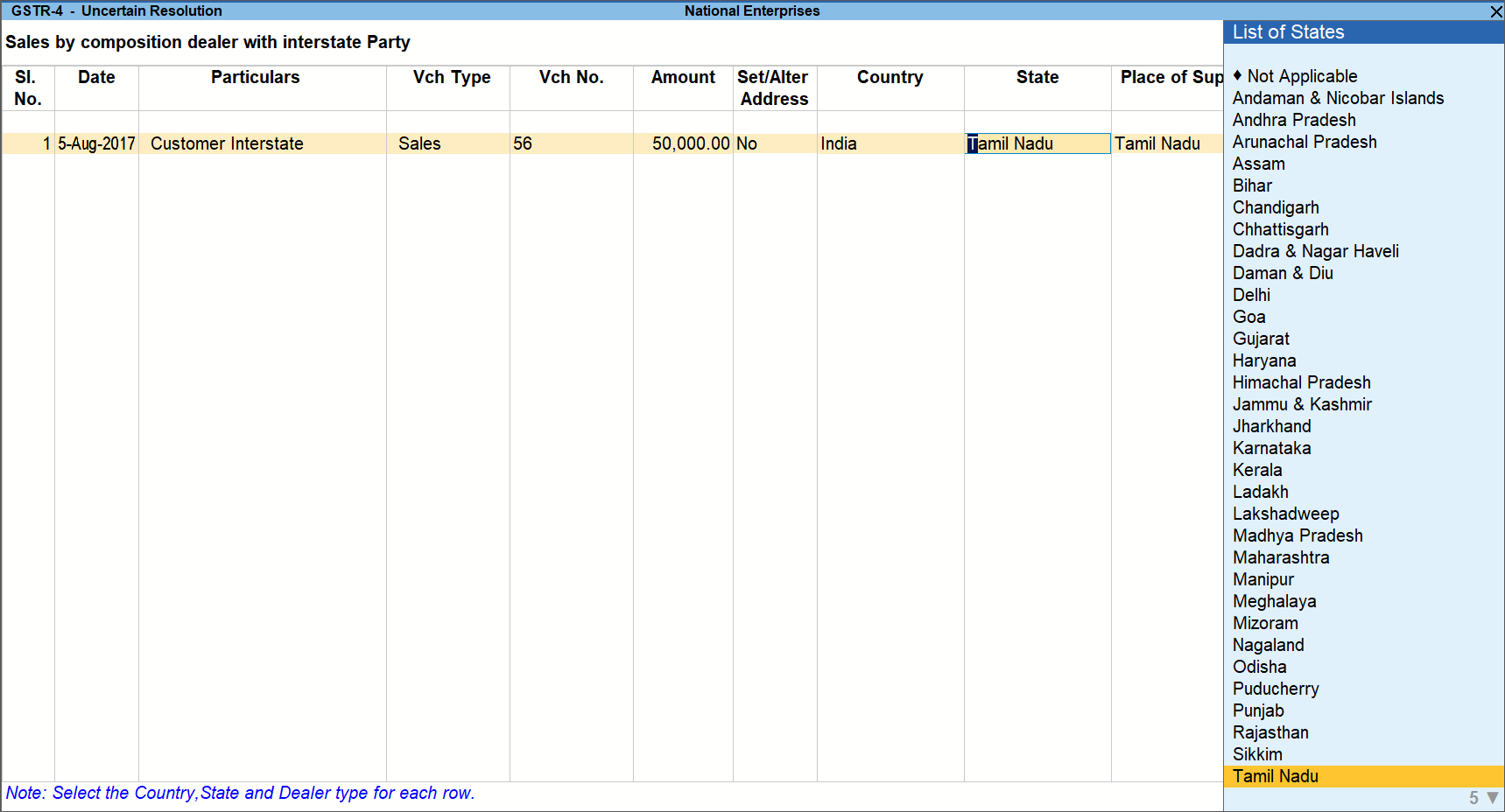
- Select the State, Place of Supply, Registration Type and enter the GSTIN/UIN. You can change the address details by pressing Backspace and setting the option Set/Alter Address to Yes.
Exception: Information required for generating table-wise details not provided
Displays the count of transactions excluded from table-wise format of GSTR-4 due to incomplete information. The button Exception Types (Ctrl+E) is provided to resolve all party ledger level or voucher level corrections from a single screen.
- Select Information required for generating table-wise details not provided, and press Enter.

- Select any voucher and press Enter to display the Exceptions as per Return Tables screen.

- If you want to accept the GSTIN/UIN as is, click C: Accept GSTIN/UIN.
- Enter the missing information or update the incorrect details, and press Enter to return to the Exception Resolution screen.
- Repeat step 4 for all the required vouchers.
View Accepted As Is
In the GSTR-4 report, press Ctrl+A to view the list of vouchers that were accepted as valid and included in the returns.

Vouchers accepted with original values: The vouchers accepted as valid from the exception Taxability, Reverse charge applicability, Taxable value, Rate of tax modified in voucher, appear here.
Press Enter to view the vouchers. To move the vouchers out of this list and make the required corrections, click A: Remove Accept As Is and press Enter. The voucher moves to the relevant exceptions.
Vouchers accepted without party GSTIN/UIN validation: The vouchers that were accepted by clicking C: Accept GSTIN/UIN in the Information required for generating table-wise details not provided exception of GSTR-4, appears here. Press Enter to view the vouchers.
To move the vouchers out of this list and make the required corrections
- Click V: Validate GSTIN/UIN.
- Press Enter.
The voucher moves back to the exception.
Details Captured in Offline Tool
Use the Microsoft Excel format to export the GSTR-4 details that need to be filed.
The description of the data captured in each sheet and columns of the exported file is given below:
|
Worksheet and column names |
Description |
|
4-A&B (B2B) 4A,4B. Inward Supplies received from a registered supplier (including supplies attracting reverse charge) |
Displays the details of local and interstate purchases made from registered dealers attracting reverse charge. |
|
GSTIN of Supplier |
Displays the GSTIN/UIN defined in the party ledgers, or entered in the Party Details screen of the voucher. |
|
Invoice Number |
Displays the Supplier invoice no. entered in the purchase voucher. |
|
Invoice date (dd-mm-yyyy) |
Displays the supplier invoice Date entered in the purchase voucher. |
|
Invoice Value |
Displays the total value of the voucher. |
|
Place Of Supply |
Displays the State name selected in the Party Details screen of the voucher. |
|
Reverse Charge |
Displays Yes. |
|
Invoice Type |
Displays Regular. |
|
Rate |
Displays the tax rate entered in the transaction. |
|
Taxable Value |
Displays the assessable value entered for each tax rate. |
|
Integrated Tax |
Displays the autocalculated value. |
|
Central Tax |
Displays the autocalculated value. |
|
State/UT Tax |
Displays the autocalculated value. |
|
Cess |
Displays the value entered in the invoice. |
|
4D(IMPS) 4D. Import of Service |
Displays the details of import of services enabled for reverse charge from dealers outside India. |
|
Invoice Number |
Displays the Supplier invoice no. entered in the purchase voucher. |
|
Invoice date (dd-mm-yyyy) |
Displays the supplier invoice Date entered in the purchase voucher. |
|
Invoice Value |
Displays the total value of the voucher. |
|
Place Of Supply |
Displays the State name selected in the Company GST Details screen. |
|
Rate |
Displays the tax rate entered in the transaction. |
|
Taxable Value |
Displays the assessable value entered for each tax rate. |
|
Integrated Tax |
Displays the autocalculated value. |
|
Cess |
Displays the value entered in the invoice. |
|
6(TXOS) 6. Tax on outward supplies made (Net of advance and goods returned) |
Displays the details of taxable sales. |
|
Turnover |
Displays the assessable value entered for each tax rate defined in Company GST Details screen. |
|
Central Tax |
Displays the autocalculated value. |
|
State/UT Tax |
Displays the autocalculated value. |
|
8A(AT) 8A. Advance amount paid for reverse charge supplies in the tax period |
Displays the value of the journal voucher recorded with the Nature of adjustment selected as Increase of Tax Liability. This is to account for tax on advance paid for purchase under reverse charge, for which purchase is not made in the same month. |
|
Place Of Supply |
Displays the Place of supply selected in the Statutory Details screen of the journal voucher (appears on enabling the option Provide GST details). |
|
Supply Type |
Displays the Supply Type selected in the Statutory Details screen of journal voucher (appears on enabling the option Provide GST details). |
|
Rate |
Displays the tax Rate entered for the tax ledgers in the GST Details screen of the journal voucher. |
|
Gross Advance Paid |
Displays the Taxable Value entered for the tax ledgers in the GST Details screen of the journal voucher. |
|
Integrated Tax |
Displays the autocalculated value. |
|
Central Tax |
Displays the autocalculated value. |
|
State/UT Tax |
Displays the autocalculated value. |
|
Cess |
Displays the value entered in the invoice. |
|
8B(ATADJ) 8B. Advance amount on which tax was paid in earlier period but invoice has been received in the current period |
Displays the value of the journal voucher recorded with the Nature of adjustment selected as Decrease of Tax Liability. This is to reverse the tax on advance paid for purchase under reverse charge in the previous period, for which purchase is made in the current period. |
|
Place Of Supply |
Displays the Place of supply selected in the Statutory Details screen of the journal voucher (appears on enabling the option Provide GST details). |
|
Supply Type |
Displays the Supply Type selected in the Statutory Details screen of the journal voucher (appears on enabling the option Provide GST details). |
|
Rate |
Displays the tax Rate entered for the tax ledgers in the GST Details screen of the journal voucher. |
|
Gross Advance Paid |
Displays the Taxable Value entered for the tax ledgers in the GST Details screen of journal voucher. |
|
Integrated Tax |
Displays the autocalculated value. |
|
Central Tax |
Displays the autocalculated value. |
|
State/UT Tax |
Displays the autocalculated value. |
|
Cess |
Displays the value entered in the invoice. |
Note: Currently, data of purchases from a regular dealer that do not attract reverse charge, purchase from unregistered dealers, credit and debit notes, and amendments will not be exported to the template.
File GSTR-4
GSTR-4 report includes the details of taxable outward supplies, and inward supplies under reverse charge, made by a GST composition dealer in a given period. With TallyPrime, you can file GSTR-4 in three easy ways:
- By generating JSON from TallyPrime
- By using the GST Offline tool
- By filing your returns directly on the GST portal
Prerequisites for filing GSTR-4
- Internet connectivity: This is required for uploading the JSON file, downloading the offline tool, and filing returns.
- Microsoft Office: For exporting data to the offline tool, GSTN recommends MS Excel 2007 or later (if you are using the offline tool for filing returns).
Method 1: Generate JSON from TallyPrime
You can quickly generate JSON from TallyPrime and upload it to the portal.
Generate GSTR-4 returns in the JSON format
- Go to Gateway of Tally > Display More Reports> Statutory Reports > GST > GSTR-4.
Alternatively, press Alt+G (Go To) > type or search GSTR-4 > press Enter. - F2: Period: Select the period for which returns need to be filed.
- Press Alt+E and select E-Return from the menu.
- Select JSON (Data Interchange) as the File Format.
- Specify the folder path to save the e-return in the File path field.
- File Name is auto-filled retain the name and press Enter.

- Click Send to export the returns in JSON format.
Note: If the company GSTIN/UIN is incorrect, you need to correct it to proceed with the export. To open the file after export, click Configure and set Open file after Export to Yes.
Upload the JSON file generated from TallyPrime to the portal for filing returns.
The latest offline tool supports data export only until 31st March 2019. Hence, if you are exporting data from April 2019 onwards, a note appears at the bottom of the Export Report screen as shown below:
The data will be exported to JSON file for reference purposes only. You cannot use this to file returns, as the department does not have a provision to file quarterly returns from 1st April 2019.
File GSTR-4 returns
- Log in to the GST portal.
- Click Services > Returns > Returns Dashboard.
- Select the Return Filing Period, and click SEARCH.
- Click GSTR4.
- Click PREPARE OFFLINE.
- Click Choose File to import the JSON file generated from TallyPrime or the offline tool. Once your JSON file is uploaded successfully, you will be notified by a message.
- Verify the uploaded details after the time specified in the GSTR screen.
- Submit your returns and e-sign.
Method 2: Use the GST Offline Tool
You can export data to the offline tool provided by the department, generate JSON and upload the same to the portal.
Download the offline tool
- Go to the GST portal.
- Click Downloads > Offline Tools > GSTR 4 Offline Tool > Download.

- Click Proceed.
- A .zip file containing the GSTR_4_Offline_Utility will be downloaded.
- Extract the file from the .zip file and copy it to the location where TallyPrime is installed.
Export GSTR-4 returns to the offline tool
- Go to Gateway of Tally > Display More Reports> Statutory Reports > GST > GSTR-1.
Alternatively, press Alt+G (Go To) > type or search GSTR-1 > press Enter. - F2: Period: Select the period for which returns need to be filed.
- Press Alt+E and select E-Return from the menu.
- Select Excel (Spreadsheet) or CSV (Comma Delimited) as the File Format.
- Specify the folder path to save the e-return in the File path field.
- Press Enter. If the template GSTR_4_Offline_Utility_v3.3.xls is not available in the File path, the message appears as shown:
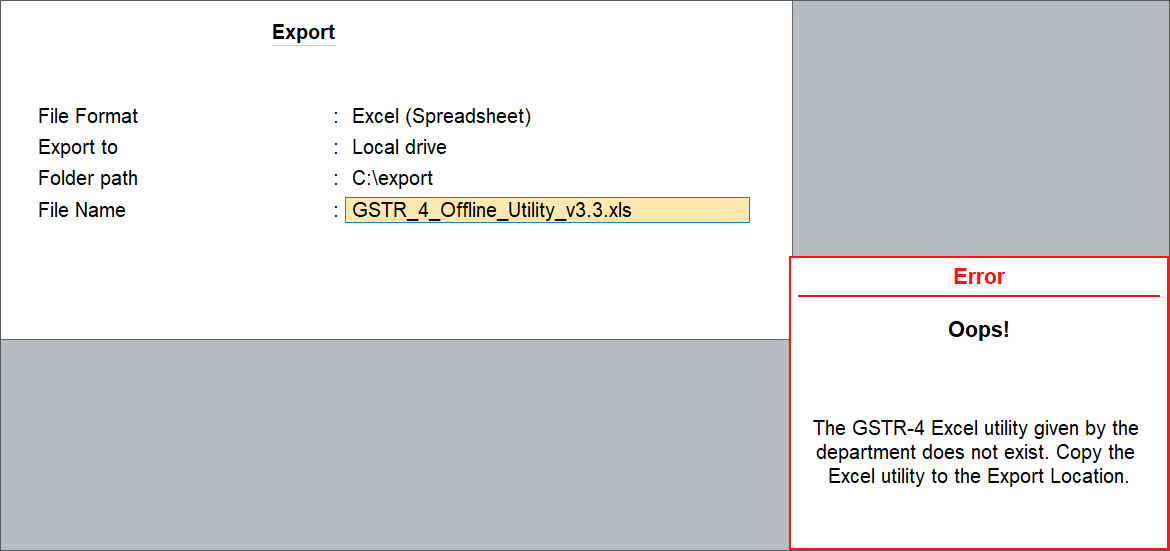
- Copy the template to the File path and continue.
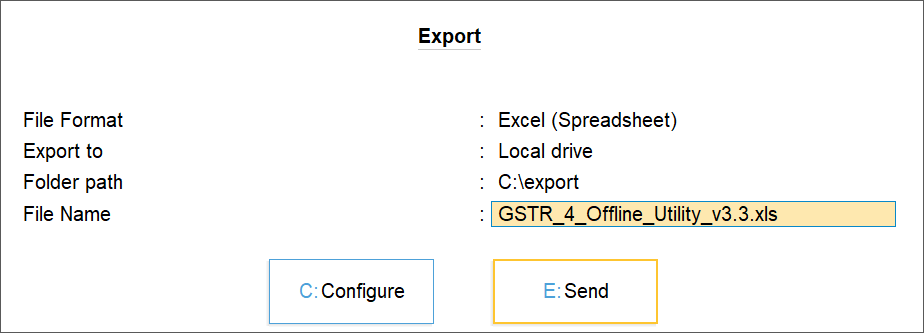
- Click Send to export.
The offline tool opens with the data updated in the relevant fields.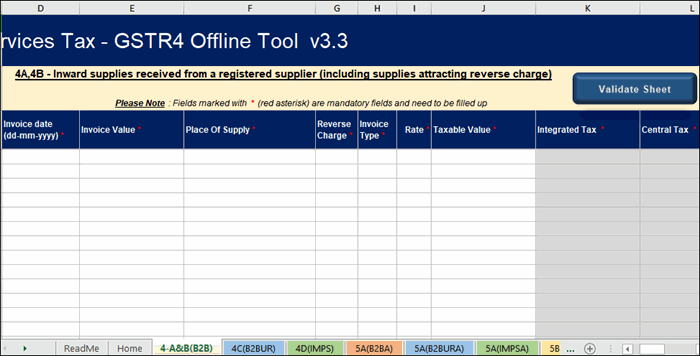
- In the offline tool click Validate Sheet to view the status of each sheet.
- In the Home tab:
- Click Get Summary.
- Click Generate JSON File to upload. On successful validation, the message appears as shown:
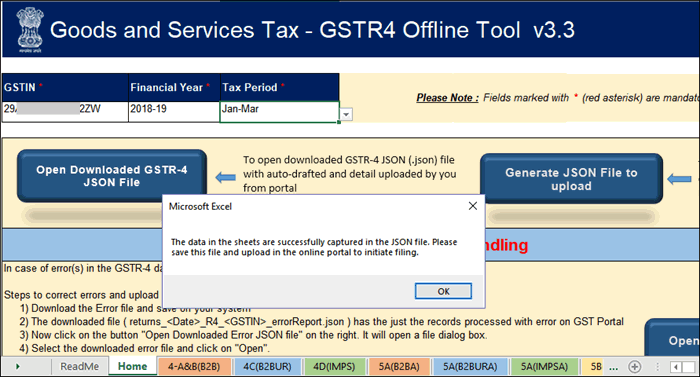
- Save the file in the required location.
- Upload this JSON file on the GST portal.
For more details on the information captured in each column of the offline tool, click here.
The latest offline tool supports data export only until 31st March 2019. Hence, if the report period is from 1st April 2019, a note appears at the bottom of the Export Report screen.
In TallyPrime, even though there is a provision to select the period from April 2019, the data will not be exported to the tool for the following reasons:
- The tool accepts data only until March 2019.
- As per Notification No. 20/2019 – Central Tax, issued by GSTN, annual returns will be applicable for composition dealers from April 2019.
If you want to export the details for reference purposes, you can press Alt+E from GSTR-4 and select Excel (Spreadsheet) format. Do NOT select Excel GSTR-4 (Spreadsheet).
Method 3: File your returns directly on the GST portal
When your data volume is very low, you can directly file the returns on the portal.
- Log in to the GST portal.
- Select the Return Filing Period, and click SEARCH.
- Click GSTR4.
- Click PREPARE ONLINE.
- Open each GSTR-4 table, copy the data exported from TallyPrime to GSTR-4 offline tool, and fill the tables.
- Submit your returns and e-sign.